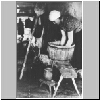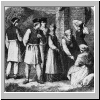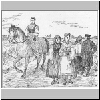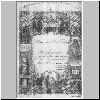| blan
|
CUSTOMS AND TRADITIONS> YOUTH TRADITIONS The Lithuanian word “youth” was used by native speakers in several senses. It denoted a stage of human life, an entertainment, and a community united by age and shared interests. In the 19th - first half of the 20th century, the greatest part of Lithuanian youth lived within compact village communities. A youth community was an autonomous social structure with its own rights, obligations, and even laws. In this chapter, we shall give an overview of some youth traditions. We shall reveal their ethnic peculiarities and links with the European youth customs. We shall indicate what heritage the youths of today have received from their ancestors. YOUTH INITIATION RITES In a great number of cultures, the beginning of girl’s physical and social maturation is linked with her first menstruation. Nations differing in the level of their cultural development emphasise this fact by initiation rites. At the end of the 19th - beginning of the 20th century, Lithuanians marked the first menstrual period within the family. In most cases only mother and daughter participated in the rite. As in some other European countries, the mother having learned about her daughter’s first menstruation would slap the girl’s face and utter a ritual formula: “bloom like a rose, be beautiful” or similar words. The ritual practice was intended to predestine the girl’s physiological development. It was believed that even the manner in which the act of slapping was performed could determine the duration of menstruation. The mystery of birth was intimated to the girl. It was believed that after this evidence of maturity the girl was fit for marriage. First bread baking, another group of rites performed in the family, is related both to physical and social maturation of an individual. The oldest description of the rite dates back to the second half of the 19th century. It gives evidence that in Dusetos girls baked their first bread on Saturday, that is on a bath-taking day, so that women assembled in a pirtis (a bathhouse for taking a bath in the Lithuanian manner) could be treated to the bread. After the daughter had baked her bread and made a special small loaf ready, the mother invited all family members including her closest female neighbour. Then she distributed the bread among them. Subsequent ritual actions were meant to notify the community about the girl’s readiness to get married. On that occasion the father usually assigned his daughter her share of family property. Later when treating female neighbours to the daughter’s bread in the bathhouse the mother informed the female community as to the amount of the assigned share. The beliefs that it is necessary to take out a baker’s peel to the entrance-room promptly after the occurrence of the first menstrual period, and other analogies compel us to make a supposition that the rites celebrating physical maturity and the beginning of housekeeping activities were once interrelated to constitute one rite of initiation. However the available ethnographic material allows us to arrange the rites celebrated within the family into a whole only hypothetically. Even if the rites constituted one initiation complex, in certain cases the girl could not acquire the status of a daughter-in-maidenhood because girls in the family were married off according to the principle of priority in birth. In the middle of the 19th century, only the oldest unmarried daughter of a farmer could practice marriage-related magic. Younger sisters did not even have a right to think about marriage before their older sisters were married off. If this order was violated, the outstripped girl either remained unmarried or entered the abnormal social category of a spinster. Mothers dressed up their oldest unmarried daughters. For example, in Kupiđkis a newly made garment was worn by the oldest daughter. Next year it was handed down to the younger daughter. Finally the completely worn out garment was given to the youngest daughter. Parents indulged the oldest unmarried daughter in a number of ways: they accumulated only her dowry, they had mass said for her. Rather often parents took the initiative in promoting in all possible ways their daughter’s readiness to marry: the oldest girl would be sent to participate in bees, youth parties, dances, to visit relations, take part in weddings; persons having no home or regular work, such as beggars, travelling dress-makers or other craftsmen would be hired to advertise the daughter’s share. Only the oldest daughter was allowed to be a bridesmaid, a godmother, to go to parties and church festivals. Only she was permitted to stay for a party organised on the occasion of a church festival. Youth community had to recognise the exceptional rights of the oldest daughter: as recently as in the interwar period in some places only the oldest unmarried daughter in the family was allowed to go to a youth party. The reason for such practice was sound: if several sisters were allowed to go, the oldest one, however young, would seem to be a spinster. Sometimes, if several sisters participated in a youth party, younger sisters did not dance until somebody invited their oldest sister to dance. The order of priority in marriage was disregarded only in case the girl was ill. If the oldest daughter had a physical defect or was unattractive, the parents willing to marry off their other daughters excluded the oldest one from the family: they either hired an apartment for her in a small town or moved her in an almshouse, or, if she was strong enough sent her to America to work there. Even in the interwar period in some places an older sister who failed to marry blocked her younger sisters the way to marriage. Such facts were recorded in all ethnographic regions of Lithuania. If the order of priority in marriage was disregarded, in some places a basket was put on the outstripped girl’s head. In this way she was symbolically excluded from youth community and closed up at home. In such case people would say that she was “put under the basket, or broom, or tub, or barrel”, or that “a horse-collar was put on her neck”, or “a block was rolled over a block”. Sometimes during a wedding party the outstripped sister was covered with dirt or an unattractive shawl. Occasionally, a wreath of plant-stalks was put on her head. This was a kind of warning to her loving parents. So they made every effort to observe the order or priority in marriage. In case of boys, the order was usually disregarded. The order of priority in marriage was stressed during wedding festivities. The oldest recordings evidence the custom of wreathing (coronation, symbolisation of virginity, assignment of rights, etc.) a girl or, less habitually, a boy. Before the bride’s leaving for her husband’s place, the bride’s wreath was put on the head of her junior sister. The wreathed lass was seated on a bench and lifted up into the air several times. (Sometimes witnesses to the event held burning splinters or tallow candles in their hands. This probably had to secure the girl against attacks of evil forces during this change of status). After that the girl’s mother or father provided refreshments to the lifters. (Sometimes, like the bride, the girl was given money to buy jewellery or clothes). In the first half of the 20th century this custom changed rapidly. A wreath, a veil or a bride’s shawl was put not only on the head of the bride’s junior sister but also on the head of her maid of honour or even on the heads of all her maids in turn. With the vanishing of the order of priority in marriage, rites lost their initiation value becoming entertainment elements in wedding festivities. However in some places the rites were preserved. Some fifty years ago in the north-eastern Lithuania the rites symbolising girl’s liberation were practised. The junior sister (or sometimes brother) was actually or symbolically dragged from behind the block of wood, or from under the bench, or the throw, or the bed, or the table, or even the tub. The area of distribution of the said type of rites also includes another group of rites marking the order of priority in marriage. These are the rites of taking off the bride’s junior sister from a dowry chest. In southern Lithuania the following practices stressing the girl’s “liberation” were also known: the girl (or sometimes a boy) was symbolically or actually pulled from under the basket. The basket was later broken to pieces during a common dance or destroyed in some other way. Today this rite is still practised in southern Lithuania. However the girl is pulled from under the basket only in case her junior sister marries first, outstripping her in this way. This custom is rather unpleasant to the “outstripped” sister because she can hear wedding guests encouraging her “not to just stand here gawking”, or to be married quicker. In some places a custom of putting the outstripped sister under the basket can be found. This practice evidencing that the girl is entering the abnormal category of a spinster existed in the interwar period. Investigation of definite forms of initiation rites practised during wedding festivities allows us to make the following conclusion: these forms must be the 19th century innovations. The overall secularisation of the mode of living practised in the village, coupled with the disintegration of the primogeniture system in the 19th century, youth leisure time innovations, the growth of girls’ social activity, and the development of cultural area must have advanced girls’ initiation rites to a wider level of village community. Boys’ rites practised within a youth community are much more archaic than the ones marking the order of priority in marriage during wedding festivities. European analogies indicate that in the course of centuries boys’ rites could have developed by way of transformation from ceremonies practised by a local community of adult males (residing in the same village, belonging to the same landlord, etc.) or a village community. At the time under investigation specific regional characteristics of initiation rites were rather prominent. In Lithuania, as well as in many other countries of West Europe, boys’ maturity was usually marked by peers’ community, while in the neighbouring Poland, Russia and in some parts of Belarus it was marked by males of various age. This was done by accepting a novice as a full and equal member of a work collective (e.g. in hay or rye cutting, etc.). Initiation rites practised by a youth community can be regarded as the rites of passage opening the door to an autonomous youth community. They stressed not the change in physical state or social status but the admittance to a close community united by age, territory and shared interests. However the entrance itself was related to a cardinal change in the social life of a girl or a boy. In a traditional society, the interests of young individuals displayed during youth gatherings were not restricted solely to having a good time or finding a mate. The local character of youth community was determined also by common interests of its members. In the interwar period there were “dark”, “light”, “good” or “bad” villages in the eastern part of Lithuania. The status of a village depended on the level of honour won by its dwellers, the village being perceived as a territorial unit. In some places of eastern and southern Lithuania, when matchmaking people paid attention not only to the morals of a possible spouse or his/her relatives but also to the status of his/her native village. Disregard for decent behaviour stereotypes established in a parish or misbehaviour of several youths could bring disgrace on the whole village. This could cause problems for all village youths wishing to find a mate in a village with a positive status. Several girls of loose morals could put even boys to some trouble. So in such villages social activities of both boys and girls were regulated by peers' community. As recently as in the interwar period in certain places of east and south Lithuania the institution of a senior bernas (a completely physically developed unmarried male in the age usual or conventional for marrying possessing all skills characteristic of an adult man) existed. The oldest unmarried man in the village (sometimes such representative of village youth was well over 50) organised the rites of admittance of younglings to youth community, imparted interaction stereotypes existing in the community to novices, and controlled activities of youth community. However in most cases activities of a youth community were co-ordinated by several boys. They also secured the maintenance of positive status of the community. In most cases rites were organised both for hirelings and landowners’ children. Rites were performed during a youth party or some other youth gathering. There are only several recordings witnessing that the rites were performed on a fixed date. Novices were usually admitted to the community in spring or summer. In more than a half of the investigated cases the rite was celebrated on behalf of one boy. In the period of investigation the rites were practised in all ethnographic regions of Lithuania, except Ţemaitija where only several such cases were recorded. In many cultures of the world boys’ initiation rites were related to the tests of the novice’s physical maturity, tortures, jeers and other practices of social pressure. Quite a number of recordings evidence the presence of social pressure in Lithuanian boys’ initiation rites in the period under investigation. Such initiation practices were diverse. A major area was occupied only by the rite practised in Suvalkija: the boy had to jump over a bench several times while members of the assembly hit him in the back with their belts. A drink to the health of the novice being drunk (by means of sending a glass of drink around), he made his last jump over the bench. The rite was distributed in Suvalkija compactly. With the reduction of the rites, boys’ skill and force tests and other practices relating to social pressure transformed into penal customs directed towards teenagers. Physical force was used on teenagers without proper qualifications to participate in youth gatherings. Thus a certain part of the rite became a reality of youth customary law. The straightforward stressing of an individual’s segregation from his/her old social structure can be found only in north-eastern Lithuania. We mean a custom of “cutting off the fetters put by the father” recorded there. (Destroyed fetters were replaced by a sash tied around the novice’s feet by a female representative of youth community). However boys’ initiation rites usually started with the first public dance followed by a repeated ritual lifting into the air. In east Lithuania admittance to a youth community was stressed by the rite of inscription into a symbolic book. After the inscription a ritual drinking usually followed. With the reduction of initiation rites, the drinking became the chief, if not the only, evidence of the rite. Girls were seldom “inscribed” as youth community members during a
youth party. Rites differed greatly. They did nor cover major area. Possibly, such
manifestations of girls’ initiation rites were a relatively recent cultural phenomena of
the end of the 19th - beginning of the 20th century. At that time
the cultural differentiation of genders faded. Sometimes girls’ physical maturity (full
development of breasts) was stressed by youths. Female newcomers to a youth party were
pinched or rubbed with the palm. However such practices could exist on two different
planes simultaneously: as a relic of initiation rites or as an obscene joke, a
manifestation of customary law resorted to when a girl deserved punishment for slander or
a refusal to dance, or when an insufficiently mature girl came to a youth party. |
blank |
|
On the confessional level, the end of childhood and the beginning of youth was spectacularly stressed by confirmation procedures of the Evangelic Lutheran Church. They emphasised girls’ and boys’ maturity identically and simultaneously. Confirmation was closely related to the completion of obligatory education period in the Lutheran Lithuania Minor. This peculiar relation could be observed there as far back as in the beginning of the 18th century. It resulted in the emergence of a fixed set of ideas about confirmation as a rite of ecclesiastic and secular initiation. Confirmation was a special event in the life of residents of Lithuania Minor. Candidates’ preparation for the special day (classes for novices; special costumes), solemn atmosphere in the church, public examination in religion, special vows, a party at home, presents and greetings given by guests, and, last but not least, the acquisition of rights enjoyed by adults (admittance to Holy Communion, a right to accumulate dowry, get employed, act as a godmother / godfather, or a bridesmaid / groomsman, etc.) gave a meaning to the confirmation as an initiation rite. Fixed age qualifications for confirmation often produced the following picture: social maturity was available to physiologically immature individuals. The initiatory value of confirmation practised by the Evangelic Lutheran Church and the Reformed Evangelic Church of Lithuania Major was less significant (in its secular sense). The absence of a bigger compact confessional community in Lithuania Major and the lack of relation between the obligatory education qualification and the confirmation accounted for it. The confirmation sacrament practised by members of the Roman Catholic Church was seldom regarded as a youth initiation rite. In southern Lithuania an individual was sometimes admitted to full membership of village youth community after a mass said to the village’s order. On that occasion youth festivities were organised in the village. Now and then boys’ and girls’ maturity was marked at the beginning of work: sowing, manuring, mowing, threshing, weaving and spinning. Sometimes the first invitation to be a godmother / godfather stressed the girl’s / boy’s maturity. The rite is still performed in the district of Tauragë. The boy is to produce the so-called “goose”, that is a bottle of strong drink decorated with feathers; the girl is to bring a basket full of food for guests. Receiving an initiation rite was a significant event both in the life of an individual and in the life of a corresponding youth community. However it did not produce sufficient grounds for a boy or a girl to become a full member of village community. In this respect the rites corresponded to various acts, very significant personally though void of legal power beyond the boundaries of community. Gaining of such rites by a youth did not necessarily result in his/her becoming an independent member of village community. On the other hand, individuals did not start independent farming even after marriage (especially in extended families). In the interwar period youths below 21, even married, were denied absolute civil capacity. Despite all this, youth initiation rites secured a chance of getting into a youth community and starting a search for a spouse. During the period of Soviet occupation an attempt to organise civil initiation rites was made. However the Soviet regime failed to create initiatory symbols. It also failed to incorporate the feelings of social and chronological identification into a novice through the organisation of the following events: solemn acceptance to the Comsomol, First Passport festivity, seeing off of a boy to the Soviet Army, or the so-called “initiation” into the rank of young workers or collective farmers. High-school graduates’ party embodied the most complex initiatory ceremonies designed to mark social maturity of a youth. However it was a very poor tribute to the Soviet ideology. In 1988 the ceremony passed away. During the party a youth danced a waltz with his/her parents, went to welcome the rising sun in the morning, lit his/her candle from a common one, or engaged in fortune telling practices. However youths did not relate the high-school graduates’ party with the rite of initiation.
|
|
| PREVIOUS |





